Immigrants from South Central Asia vs Immigrants from England Vision Disability
COMPARE
Immigrants from South Central Asia
Immigrants from England
Vision Disability
Vision Disability Comparison
Immigrants from South Central Asia
Immigrants from England
1.8%
VISION DISABILITY
100.0/ 100
METRIC RATING
7th/ 347
METRIC RANK
2.1%
VISION DISABILITY
62.8/ 100
METRIC RATING
166th/ 347
METRIC RANK
Immigrants from South Central Asia vs Immigrants from England Vision Disability Correlation Chart
The statistical analysis conducted on geographies consisting of 472,559,248 people shows a weak negative correlation between the proportion of Immigrants from South Central Asia and percentage of population with vision disability in the United States with a correlation coefficient (R) of -0.245 and weighted average of 1.8%. Similarly, the statistical analysis conducted on geographies consisting of 391,606,709 people shows a mild positive correlation between the proportion of Immigrants from England and percentage of population with vision disability in the United States with a correlation coefficient (R) of 0.390 and weighted average of 2.1%, a difference of 20.3%.

Vision Disability Correlation Summary
| Measurement | Immigrants from South Central Asia | Immigrants from England |
| Minimum | 0.18% | 0.66% |
| Maximum | 4.4% | 13.2% |
| Range | 4.2% | 12.5% |
| Mean | 1.5% | 3.6% |
| Median | 1.5% | 2.5% |
| Interquartile 25% (IQ1) | 1.2% | 2.1% |
| Interquartile 75% (IQ3) | 1.7% | 4.4% |
| Interquartile Range (IQR) | 0.50% | 2.3% |
| Standard Deviation (Sample) | 0.60% | 2.7% |
| Standard Deviation (Population) | 0.60% | 2.6% |
Similar Demographics by Vision Disability
Demographics Similar to Immigrants from South Central Asia by Vision Disability
In terms of vision disability, the demographic groups most similar to Immigrants from South Central Asia are Immigrants from Iran (1.8%, a difference of 0.060%), Iranian (1.8%, a difference of 0.15%), Okinawan (1.8%, a difference of 0.65%), Immigrants from Singapore (1.8%, a difference of 0.89%), and Immigrants from Hong Kong (1.8%, a difference of 1.1%).
| Demographics | Rating | Rank | Vision Disability |
| Immigrants | India | 100.0 /100 | #1 | Exceptional 1.7% |
| Filipinos | 100.0 /100 | #2 | Exceptional 1.7% |
| Immigrants | Taiwan | 100.0 /100 | #3 | Exceptional 1.7% |
| Thais | 100.0 /100 | #4 | Exceptional 1.7% |
| Okinawans | 100.0 /100 | #5 | Exceptional 1.8% |
| Immigrants | Iran | 100.0 /100 | #6 | Exceptional 1.8% |
| Immigrants | South Central Asia | 100.0 /100 | #7 | Exceptional 1.8% |
| Iranians | 100.0 /100 | #8 | Exceptional 1.8% |
| Immigrants | Singapore | 100.0 /100 | #9 | Exceptional 1.8% |
| Immigrants | Hong Kong | 100.0 /100 | #10 | Exceptional 1.8% |
| Immigrants | Israel | 100.0 /100 | #11 | Exceptional 1.8% |
| Immigrants | Korea | 100.0 /100 | #12 | Exceptional 1.8% |
| Immigrants | Eastern Asia | 100.0 /100 | #13 | Exceptional 1.8% |
| Immigrants | China | 100.0 /100 | #14 | Exceptional 1.8% |
| Immigrants | Bolivia | 100.0 /100 | #15 | Exceptional 1.8% |
Demographics Similar to Immigrants from England by Vision Disability
In terms of vision disability, the demographic groups most similar to Immigrants from England are Immigrants from Africa (2.1%, a difference of 0.010%), Brazilian (2.1%, a difference of 0.040%), Immigrants from Iraq (2.1%, a difference of 0.14%), Immigrants from Bangladesh (2.1%, a difference of 0.19%), and Icelander (2.1%, a difference of 0.23%).
| Demographics | Rating | Rank | Vision Disability |
| South Africans | 69.8 /100 | #159 | Good 2.1% |
| Austrians | 69.0 /100 | #160 | Good 2.1% |
| Iraqis | 67.7 /100 | #161 | Good 2.1% |
| Hungarians | 67.4 /100 | #162 | Good 2.1% |
| Icelanders | 66.1 /100 | #163 | Good 2.1% |
| Immigrants | Bangladesh | 65.5 /100 | #164 | Good 2.1% |
| Immigrants | Iraq | 64.8 /100 | #165 | Good 2.1% |
| Immigrants | England | 62.8 /100 | #166 | Good 2.1% |
| Immigrants | Africa | 62.6 /100 | #167 | Good 2.1% |
| Brazilians | 62.2 /100 | #168 | Good 2.1% |
| South American Indians | 57.4 /100 | #169 | Average 2.2% |
| Swiss | 55.7 /100 | #170 | Average 2.2% |
| Lebanese | 54.3 /100 | #171 | Average 2.2% |
| Northern Europeans | 50.1 /100 | #172 | Average 2.2% |
| Scandinavians | 50.0 /100 | #173 | Average 2.2% |